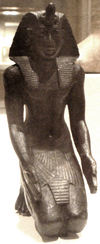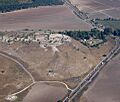Battle of Megiddo (609 BC) facts for kids
Quick facts for kids Battle of Megiddo (609 BC) |
|||||||||
|---|---|---|---|---|---|---|---|---|---|
| Part of Medo-Babylonian conquest of the Assyrian Empire | |||||||||
 A small kneeling bronze statuette, likely depicting the Egyptian pharaoh Necho II, currently on display at the Brooklyn Museum. |
|||||||||
|
|||||||||
| Belligerents | |||||||||
| Twenty-sixth Dynasty of Egypt | Kingdom of Judah | ||||||||
| Commanders and leaders | |||||||||
| Necho II | Josiah † | ||||||||
| Strength | |||||||||
| Unknown | Unknown | ||||||||
| Casualties and losses | |||||||||
| Undetermined, but low | Undetermined, but high | ||||||||
The Battle of Megiddo in 609 BC was an important fight in ancient times. It happened when Pharaoh Necho II of Egypt led his army north. His goal was to help his allies, the Neo-Assyrian Empire, fight against the rising Neo-Babylonian Empire. To get there, the Egyptian army had to pass through the land of Judah.
The king of Judah, Josiah, did not want the Egyptians to cross his land. So, Josiah's forces fought the Egyptians at a place called Megiddo. Sadly, King Josiah died in this battle. After the battle, Judah became a "vassal state" of Egypt. This means Judah was controlled by Egypt and had to pay tribute. This battle is mentioned in the Hebrew Bible, an old Greek text called 1 Esdras, and the writings of a Jewish historian named Josephus.
Even though Necho II took control of Judah, his Assyrian allies lost to the Babylonians and Medes at the Fall of Harran. After this, Assyria mostly stopped being an independent country.
Contents
What the Bible Says
The story of the Battle of Megiddo is told in the Hebrew Bible.
In 2 Kings
The book of 2 Kings (written around 550 BC) gives a short account. It says that Pharaoh Necho II of Egypt went to fight the king of Assyria near the Euphrates River. King Josiah went to meet him, and Necho killed Josiah at Megiddo. Josiah's servants then carried him back to Jerusalem in a chariot and buried him.
In 2 Chronicles
A longer story is found in II Chronicles (written later, around 350–300 BC). This version says that after Josiah had fixed up the temple, Necho came to fight at Carchemish. Josiah went out to meet him. Necho sent messengers to Josiah, saying he wasn't fighting Judah, but another enemy. He warned Josiah not to get in God's way.
However, Josiah didn't listen. He disguised himself and went to fight on the plain of Megiddo. Archers shot King Josiah, and he was badly wounded. His servants took him from his chariot and brought him to Jerusalem, where he died.
Other Ancient Stories
Jewish Accounts
The account in Esdras is similar to the one in Book of Chronicles. It says Josiah was only "weak" at Megiddo and asked to be taken back to Jerusalem, where he died. This matches an older prophecy.
Centuries later, Josephus, a Jewish historian, also wrote about the battle. He added more details about Josiah's actions during the fight. Some think he used lost documents, but others believe he based it on the Bible and his own ideas.
The battle is also talked about in the Talmud, an important Jewish text. It says Josiah didn't let the Egyptians pass because of a Bible verse that warns against swords passing through the land.
Another Jewish text, the Kinnah for the 9th of Av, also mentions the battle. It describes the Judeans holding the high ground and shooting arrows at the Egyptians. Egyptian chariots pushed them back, and then Egyptian foot soldiers attacked. King Josiah tried to keep his soldiers' spirits up. Egyptian archers focused on Josiah, hitting him many times. He was badly wounded and taken away. When their king left, the Judean army lost hope and ran away.
Greek Accounts
Some historians think the Greek writer Herodotus might have written about this battle in his famous book, Histories. He mentions Pharaoh Necho fighting a big battle at "Magdolos" against the Syrians and then taking "Cadytis," a large city in Syria. This could be a reference to Megiddo and Jerusalem.
Where the Battle Happened

Megiddo is a small hill on a raised area, near a large flat plain. This plain was big enough for thousands of soldiers. Even though it's not a huge mountain, it overlooks the area. It was a good place for a military base because it had water from the Kishon River. This is why King Josiah tried to hide his approach. He wanted to surprise the Egyptian army as they marched to fight the Babylonians.
What Happened Next
After the battle, Judah came under the control of Egypt. When Pharaoh Necho II returned from Syria and Mesopotamia, he captured and removed the new Judean king, Jehoahaz. Jehoahaz was Josiah's son and had just become king.
Necho made Judah pay a large tribute: about 3.4 metric tons of silver and 34 kg of gold. He then made Jehoahaz's older brother, Eliakim, the new king and renamed him Jehoiakim. Jehoahaz was taken to Egypt as a prisoner. He was the first king of Judah to die while exiled in another country.
See also
- Megiddo
- Fall of Harran
Images for kids


